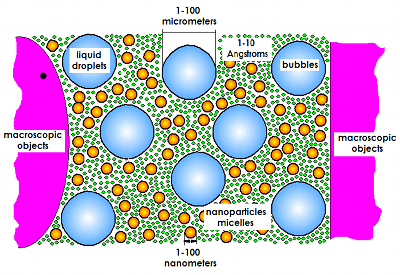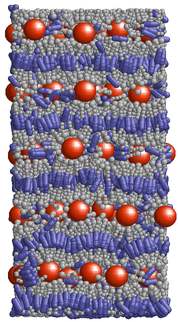Research / Main fundamental results / Soft Matter Physics
Soft Matter Physics
Physics of soft matter, a relatively young field of natural sciences, is tightly linked to the cutting edge of modern technology progress and, as a result, it is intensively developing. The concept of soft matter arose up more than 30 years ago and now it finds its important place in the physics of condensed systems. Currently the term encircles a wide range of objects that traditionally belonged to the field of chemical, biological and material sciences.
The ICMP is a base institution of the NAS of Ukraine that coordinates the research in the area of physics of soft matter and it coordinates the activity of Scientific Council “Physics of soft matter” at the Division of Physics and Astronomy of the NAS of Ukraine. A broad spectrum of fundamental theoretical and computer-based studies, conducted in the framework of various scientific programs and projects, has a principle aim to improve our understanding of physical aspects of various phenomena that take place in soft matter (M.F.Holovko, I.M.Mryglod, T.M. Bryk, A.D.Trokhymchuk, Yu.V. Kalyuzhnyi, S.P. Hlushak, J.M. Ilnytskyi, A.B. Baumketner). Particular focus is given to the following soft matter objects:
 Colloidal dispersions are characterized by a simultaneous presence of species with geometrical sizes of different spatial scales ranging from molecular and nanometric to macroscopic ones. For description of such systems was developed a general theory of effective interactions, that takes into account a specific, related to the simultaneous presence of a distinct length scales. It is shown that both deviations from the spherical form of small particles and increase of polydispersity of their sizes, result in a weakening of the effeective repulsion between the surfaces of large colloidal particles. Methods of the theory of liquids were generalized in order to describe the phase behavior of polydisperse colloidal systems. It was shown that the polydispersity extends the range of phase coexistence in comparison to the case of monodisperse systems.
Colloidal dispersions are characterized by a simultaneous presence of species with geometrical sizes of different spatial scales ranging from molecular and nanometric to macroscopic ones. For description of such systems was developed a general theory of effective interactions, that takes into account a specific, related to the simultaneous presence of a distinct length scales. It is shown that both deviations from the spherical form of small particles and increase of polydispersity of their sizes, result in a weakening of the effeective repulsion between the surfaces of large colloidal particles. Methods of the theory of liquids were generalized in order to describe the phase behavior of polydisperse colloidal systems. It was shown that the polydispersity extends the range of phase coexistence in comparison to the case of monodisperse systems.
For electrolyte colloidal solutions the molecular theory of hydration interactions was formulated and the mechanism of formation of thin colloidal films, that explains the nature of the observed phenomenon of the discrete step-by-step decrease of the thickness of colloidal films, was suggested. The obtained results were applied to interpretation of experiments on the stability of ion-micellar surfactant solutions.
Liquid crystal systems: A method of Ornstein-Zernike integral equations was generalized for description of properties of pure liquid crystals and liquid crystal colloids. A number of new molecular models was proposed, in framework of which various features of nematic phase transitions were investigated. A molecular theory of effective colloidal interactions in anisotropic media was developed for the case of applied external fields.

Theoretical studies of solvation processes were conducted for polar liquid crystal nematics. In particular, a theory was developed for description of reactions of electron transfer in liquid crystals. A prediction, that in slowly relaxing liquid-crystal systems the reaction of electron transfer can take place in both ergodic and non-ergodic regims, was made.
The computer modeling of orientational ordering of small molecules (such as, acetylene, propin, benzol, betin et al) in nematic liquid crystal was conducted. The obtained results were extraordinarily important for development of theoretical models and were used for interpretation of experimental measurements by the NMR method.
Molecular dynamics simulations were applied to study of relaxation of the third generation of liquid crystal dendrimer in isotropic, nematic and smectic A solvent. Essential anisotropy of dendrimer conformation was observed in orientationally ordered phases. The melt of 100 dendrimer molecules was studied in the bulk using coarse-grained molecular dynamics. The self-assembly into smectic A and columnar phase was observed with the application of external field with appropriate symmetry, that confirmed the shape-phase relations observed experimentally.
 The structure and internal dynamics of side-chain liquid crystalline polymers were studied in isotropic, polydomain and smectic A phases. Using a classical mechanics model for the photoisomerisation of azobenzene chromophores the effect of fotoinduced deformation in azobenzene-containing films was studied microscopically by molecular dynamics simulations.
The structure and internal dynamics of side-chain liquid crystalline polymers were studied in isotropic, polydomain and smectic A phases. Using a classical mechanics model for the photoisomerisation of azobenzene chromophores the effect of fotoinduced deformation in azobenzene-containing films was studied microscopically by molecular dynamics simulations.
Macromolecular systems include polymer and biopolymer solutions, polymer melts and colloid-polymeric mixtures. Theoretical and computer simulation studies of structural properties for systems composed of the polymers with various topology, such as star polymers in a good solvent and melts of star molecules, were conducted. Ab initio molecular dynamics and integral equation theory were applied to study the hydration structure of chain molecules with hydrophobic and hydrophilic groups, that is of great importance for analysis of conformation properties of biopolymers.
A theory for evaluation of the phase diagram of polydisperse mixture of colloids and chain molecules was developed. An analysis of the complete phase diagram obtained for such mixture was performed by this theory. It was shown that colloid-polymer systems separate into the phases enriched by colloid particles and dense polymer phase.
The self assembling systems arise when amphiphilic molecules are dissolved in aqueous-nonpolar solutions. For such systems a simple nontrivial model of reverse micelles that allow presence of the protein was formulated. The proposed model is used to analyze experimental data on dissolution of the cytochrome molecules in aqueous solutions of reverse micelles. A shift of the percolation point in the area of small micellar concentrations was obtained and existence of threshold value of concentration was predicted. Problems of dissolution of non-polar molecules into direct micelles with a purpose of their transport in water environments including purposeful delivery of medications in living organisms were studied too.
A method of dissipative dynamics was applied to the computer simulation of morphological features and analysis of molecular conformations for linear, comb and star-like copolymers and their mixtures. Depending on molecular architecture and molar fraction the wide variety of morphologies, including cubic, hexagonal, lamelar, bicontinual and others, was found.
In a field of biological systems, such as proteins and membranes, the studies on a problem of folding of model protein in the structural state consisting of three alpha spirals were conducted. A problem of an early stage of protein aggregation, when relatively small oligomers appear, was studied on molecular level.
Simulation studies of the structure and reaction of folding reaction of different modifications of a special type of protein - amyloid beta of peptide (Ab) that is related to the Alzheimer’s disease, were conducted. In this direction, the microscopic structure of Ab of albumens, that are formed at Alzheimer’s disease, was obtained for the first time. Reliability of the results was confirmed by comparing them with the results of scattering experiments.
Studies of an effective interaction that is induced between protein molecules upon adding of neutral or charged oligomeric molecules of different length to the system were conducted. Such studies are of practical interest since the presence of oligomers decreases the coagulation stability of protein solutions.